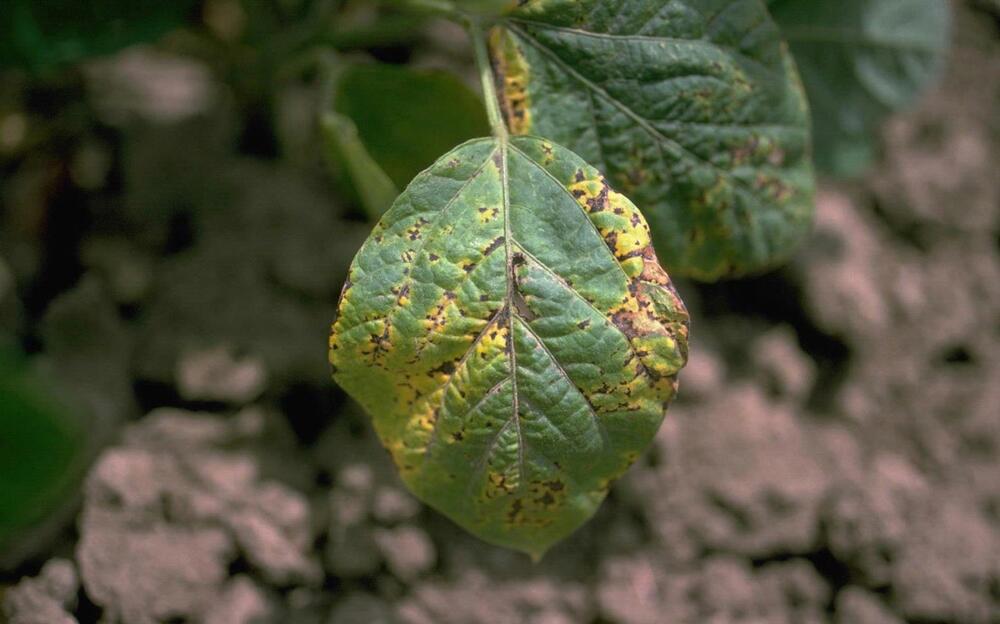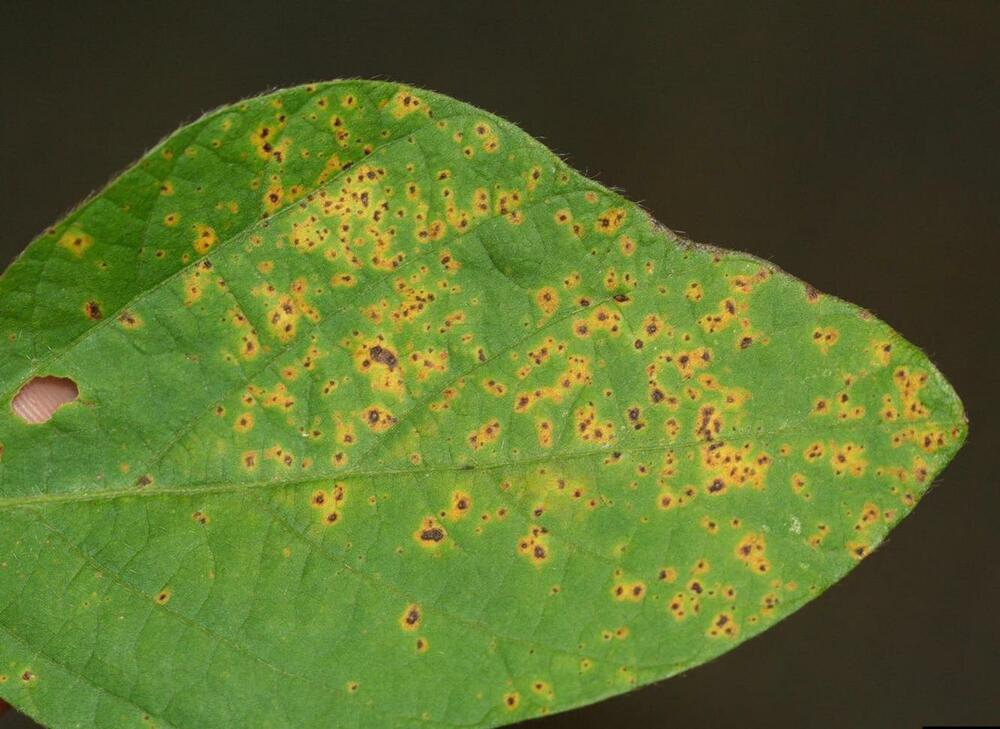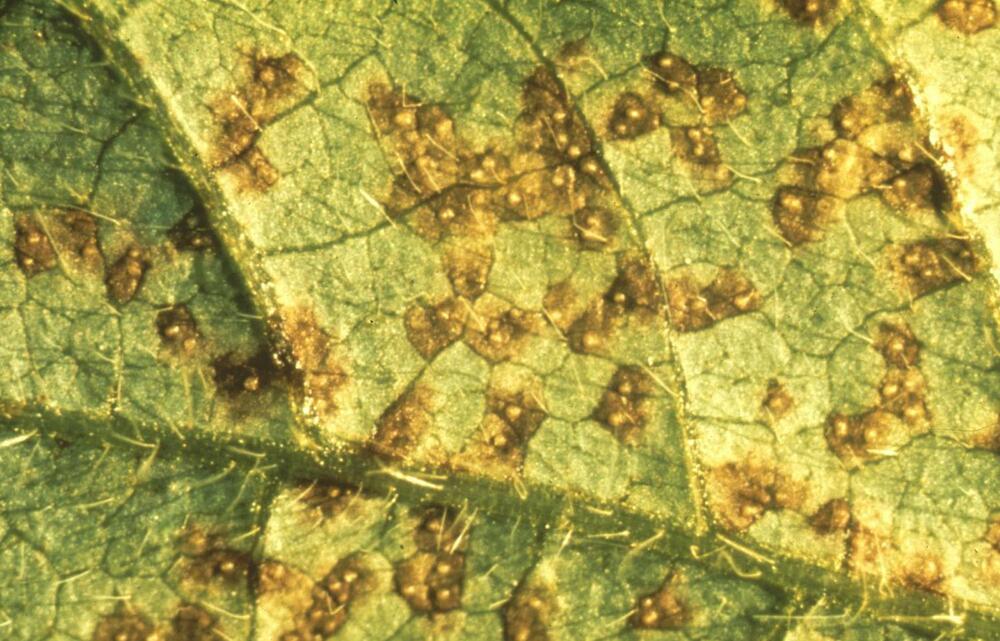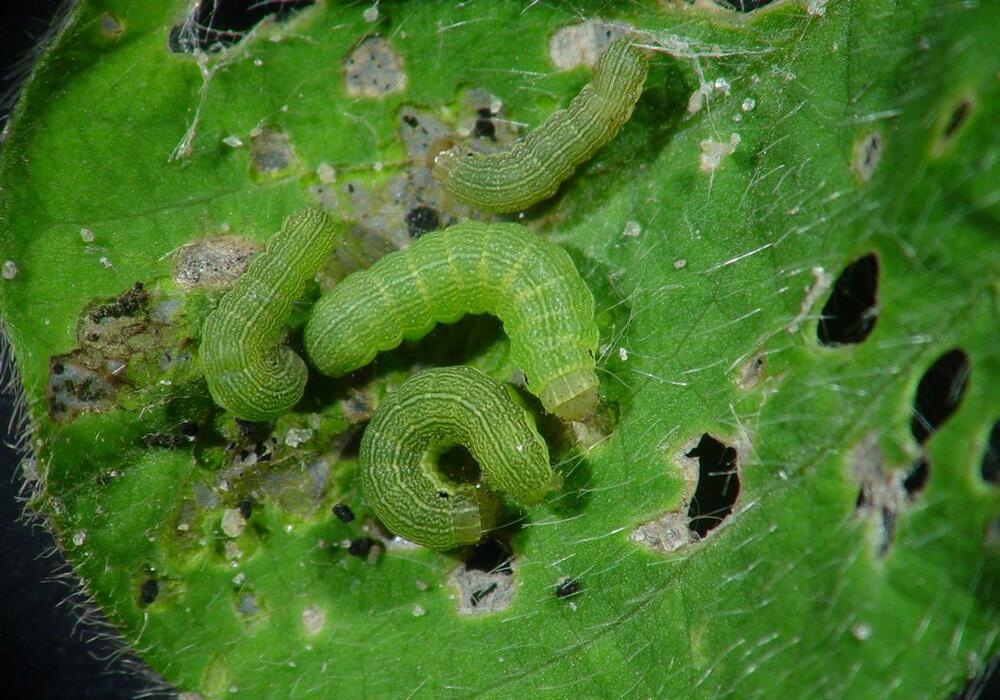Soybean
Description
Uses
Propagation
References
Common Pests and Diseases
Diseases
Category : Bacterial
Bacterial blight Pseudomonas syringae
Symptoms
Water-soaked spots on leaves which enlarge and become necrotic; spots may be surrounded by a zone of yellow discoloration; lesions coalesce and give plant a burned appearance; leaves that die remain attached to plant; circular, sunken, red-brown lesion may be present on pods; pod lesions may ooze during humid conditions
Cause
Bacterium
Comments
Disease can be introduced by contaminated seed; bacteria overwinters in crop debris; disease emergence favored by warm temperatures; spread is greatest during humid, wet weather conditions
Management
Plant only certified seed; plant resistant varieties; treat seeds with an appropriate antibiotic prior to planting to kill off bacteria; spray plants with an appropriate protective copper based fungicide before appearance of symptomsBacterial pustule Xanthomonas campestris
Symptoms
Tiny pale green spots with raised centers on both upper and lower leaf surfaces which develop raised pustules in lesion center; pustules usually form in lesions on lower leaf surface; mottled brown areas may develop on leaves if lesions coalesce; small red-brown spots may develop on pods of some varieties
Cause
Bacteria
Comments
Disease is prevalent in soybean growing regions which experience warm temperatures and frequent rainfall during the growing season
Management
Plant varieties of soybean that are resistant to bacterial pustule; spray plants with an appropriate protective copper based fungicide before appearance of symptomsCategory : Fungal
Rhizoctonia stem rot Rhizoctonia solani
Symptoms
Damping-off (pre- or post-emergence death) of seedlings caused by red-brown lesions which girdle the stem; lesions or cankers may be present on the stem of older plants and cause the death of the plant mid-season
Cause
Fungus
Comments
Disease emergence favors warm, dry soil and subsequent rainfall
Management
Treat seeds with an appropriate fungicide prior to planting; plant less susceptible varieties of soybean; plant only in well-draining soilsRust Phakopsora pachyrhizi
Symptoms
Gray or red-brown water-soaked spots on leaves which turn are tan to dark reddish brown in color lesions may also be present on stems, petioles and pods; volcano-shaped uredinia (spore producing structures) are present within the lesions; plants drop leaves and mature prematurely
Cause
Fungus
Comments
Rust development is favored by warm temperatures and periods of high humidity
Management
Plant soybean varieties that are resistant to rust; applications of appropriate foliar fungicides can help to control the diseaseSclerotinia stem rot Sclerotinia sclerotiorum
Symptoms
Upper leaves of plant become wilted and die; leaves turn a gray-green color and dry out; water-soaked lesions on stem nodes which change color from tan to white; lesions may girdle the stem and infection may spread to both side branches and pods; cottony white mycelial growth occurs on all infected plant parts
Cause
Fungus
Comments
Disease emergence favors cool, wet weather; pathogen is resistant to many fungicides
Management
Do not plant soybeans in fields where common bean, sunflowers or other susceptible crops have been grown the previous season; space plants in narrow rows; avoid excessive irrigation after plants are no longer flowering; plant soybean varieties that are less susceptible to the diseaseSeptoria Leaf Blight Septoria glycines
Symptoms
Cause
Comments
Pests
Category : Insects
Armyworms (Beet armyworm, Western striped armyworm)
Spodoptera exigua
Spodoptera praefica
Symptoms
Singular, or closely grouped circular to irregularly shaped holes in foliage; heavy feeding by young larvae leads to skeletonized leaves; shallow, dry wounds on fruit; egg clusters of 50-150 eggs may be present on the leaves; egg clusters are covered in a whitish scale which gives the cluster a cottony or fuzzy appearance; young larvae are pale green to yellow in color while older larvae are generally darker green with a dark and light line running along the side of their body and a pink or yellow underside
Cause
Insect
Comments
Insect can go through 3–5 generations a year
Management
Organic methods of controlling armyworms include biological control by natural enemies which parasitize the larvae and the application of Bacillus thuringiensis; there are chemicals available for commercial control but many that are available for the home garden do not provide adequate control of the larvae
Cucumber beetles (Western striped cucumber beetle, Western spotted cucumber beetle)
Acalymma vittata
Diabrotica undecimpunctata
Symptoms
Stunted seedling; damaged leaves, stems and/or petioles; reduced plant stand; plants may exhibit symptoms of bacterial wilt; scars on fruit caused by beetle feeding damage; adult beetles are brightly colored with either a green-yellow background and black spots or alternating black and yellow stripe
Cause
Insect
Comments
Beetles overwinter in soil and leaf litter and emerge from soil when temperatures begin to reach and exceed 12.7°C (55°F)
Management
Monitor new planting regularly for signs of beetle; floating row covers can be used to protect the plants from damage but will need to be removed at bloom to allow bees to pollinate plants; applications of kaolin clay can be effective for management of small beetle populations; application of appropriate insecticides may be necessaryMexican bean beetle Epilachna varivestis
Symptoms
Irregular patches of feeding damage on underside of leaves which causes the top surface of the leaf to dry out, giving the leaves a lacy appearance; insect will also damage flowers and small pods; pods may be damaged so badly that they drop from the plant; adult insect is an orange-brown beetle with black spots; larvae are fat-bodied grubs which taper at the end and are in rows of conspicuous spines
Cause
Insect
Comments
Beetles can decimate bean crops; beetles overwinter as adults and undergo 2-3 generations per year
Management
Some bean varieties may be less attractive hosts for the beetle, e.g. snapbeans are preferred hosts over lima beans; early varieties may escape damage form beetles beetle populations can be reduced by remove overwintering sites such as brush and leaves on the ground; handpick larvae and adults; brush eggs from leaves and destroy; apply insecticidal soap to leaf undersides if infestation is heavyCategory : Others
Brown spot Septoria glycines
Symptoms
Upper leaves have light purple discoloration and a leathery appearance and bronzing of leaves may occur; red-purple angular or irregularly shaped lesions develop on both the upper and lower leaf surfaces and may coalesce to form large necrotic patches; multiple infections can cause chlorosis and defoliation of the plants; on petioles and stems, sunken red-purple lesions may develop and upper leaves appear blighted.
Cause
Fungus
Comments
Disease emergence favors warm, wet weather which promotes sporulation of the fungus; dry weather prevent the spread of the disease
Management
Plow crop residue into soil after harvest; plant soybean varieties that are less suceptible to the disease; rotate crops to a non-susceptible crop for at least one year; apply an appropriate foliar fungicide to protect plants from bloom to pod fillCercospora leaf blight Cercospora kikuchii
Symptoms
Upper leaves turning yellow; purple-red lesions are present on leaves and coalesce to give the leaves a bronzed appearance; leaves develop a leathery texture; severe infections give leaves a blighted appearance and cause them to drop from the plant
Cause
Fungus
Comments
Disease development id favored by warm temperatures and high humidity
Management
No soybean varieties are immune to the disease but some have more resistance than others and can give some degree of control; crop debris should be plowed into soil following harvest to reduce build up of inoculumCharcoal rot Macrophomina phaseolina
Symptoms
Discoloration of stem at soil line; cankers on stem may spread upwards; leaves may wilt and drop from plant; numerous small black sclerota (fungal fruiting bodies) develop in affected tissues and can be used to diagnose the disease
Cause
Fungus
Comments
Fungus had a wide host range and affects beans, tobacco, cowpea, pigeon pea and many other crops; disease is primarily spread via microsclerota in the soil
Management
Organic soil amendments such as the addition of manure or neemcake can be used to reduce levels of inoculum in the soilDowny mildew Peronospora manshurica
Symptoms
Yellow or pale green spots on upper surfaces of leaves which enlarge and coalesce to form yellow patches; lesions may turn gray-brown to dark brown with a yellow margin; fuzzy tufts of gray-purple mold develop on lesions on underside of leaves; infection of pods can cause seeds to be covered in masses of white mycelia with pods showing no external symptoms
Cause
Fungus
Comments
Disease emergence favors warm temperatures and periods of high humidity
Management
Treat seeds with an appropriate fungicide prior to planting; plow soybean residue into soil after harvest; grow soybean varieties which are resistant to the disease where possible; rotate crop away from soybean for a one year periodFrogeye leaf spot Cercospora sojina
Symptoms
Angular gray spots with purple to red-brown edges on leaves; brown to black fungal structures developing in the center of the spot; circular or elongated lesions where inner membrane of pod contacts the seeds;
Cause
Fungus
Comments
Disease emergence favors warm and humid conditions
Management
Plant high quality seed and use resistant varieties; rotate crop away from soybean for a period of 2 years; treat seeds with appropriate fungicide prior to planting; apply appropriate foliar fungicidePhytophthora rot Phytophthora megasperma
Symptoms
Susceptible varieties of soybean may have water-soaked stems and yellowing leaves; yellowing occurs between leaf veins and along leaf margins; upper leaves of plant become chlorotic and wilted; tolerant soybean varieties may show stunted growth and slight yellowing
Cause
Oomycete
Comments
Disease emergence favors heavy, water saturated soil; flooded soil within 1 week of planting is most conducive to disease development
























